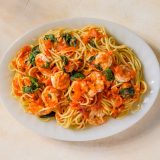A web of water and arched bridges, the stitching that tethers the cluster of islands that is Venice. On the main island—Centro Storico—it’s easy to be dazzled, ocher- and sunflower-colored buildings splashing sunlight onto canals where narrow stairwells descend to waves lapping luminescent green.
Of course, the real Venice is beyond the postcard pretty. Grab a water taxi to the outer islands and you’re in Venice’s version of the suburbs. It’s how I find myself in Lido, a narrow barrier island a world away from the throngs of tourists.
Here, there are cars, yet the streets are quiet. The pacing is calmer, the views of the water less obstructed. And it’s here that I meet Marika Contaldo Seguso, a cookbook author who documents the city’s culinary traditions, and her husband, a 23rd-generation glassmaker whose family has been in the craft on neighboring Murano island since 1397.
Seguso begins my education on Venetian cooking with a history lesson. Location being everything, much of the cuisine begins with the bounty of the lagoon, which also determined what would become the dominant flavor profile of so many foods. That is, sweet and sour.
It’s a gentle push and pull credited to the long history of Venetians using vinegar and sugar to preserve seafood. It’s not a bold—albeit delicious—flavor stroke like Vietnamese caramel shrimp. Rather, it’s a more gentle contrast that lends subtle complexity to the dish. To demonstrate, Seguso offers to teach me scampi alla busara, or prawns poached in tomatoes.
The cooking is simple; the flavors are anything but. In a large skillet, she heats oil with garlic cloves and shell-on prawns just long enough for both to flavor the fat. The garlic then is discarded, the prawns are set aside. A splash of white wine sizzles, then chopped tomatoes, torn fresh basil and red pepper flakes are added.
The sauce cooks down until it is thick and almost jammy, the taste bright and sharp. Seguso then adds a hint of white sugar—maybe 2 teaspoons—just enough to round out the flavor of the tomatoes and underline their sweetness without dulling their tang. When she is happy, spaghetti cooked just shy of al dente in a bare amount of water is added.
The starchy water that clings to the pasta as she forks it into the skillet helps thicken the sauce further. Eventually, the prawns return to the pan to finish cooking in the gentle heat of the sauce and pasta. The result is rich, sweet, tangy and briny with flavors that run deeper than the simple ingredients suggest.
It’s a craveable combination, and one that makes me glad to have slipped free of the clamoring crowds.
In Lido, We Learn the Real Taste of Venice
Briefly simmering shrimp tails in the wine sauce easily builds extra flavor.
Photo: Connie Miller of CB Creatives; Styling: Christine Tobin








